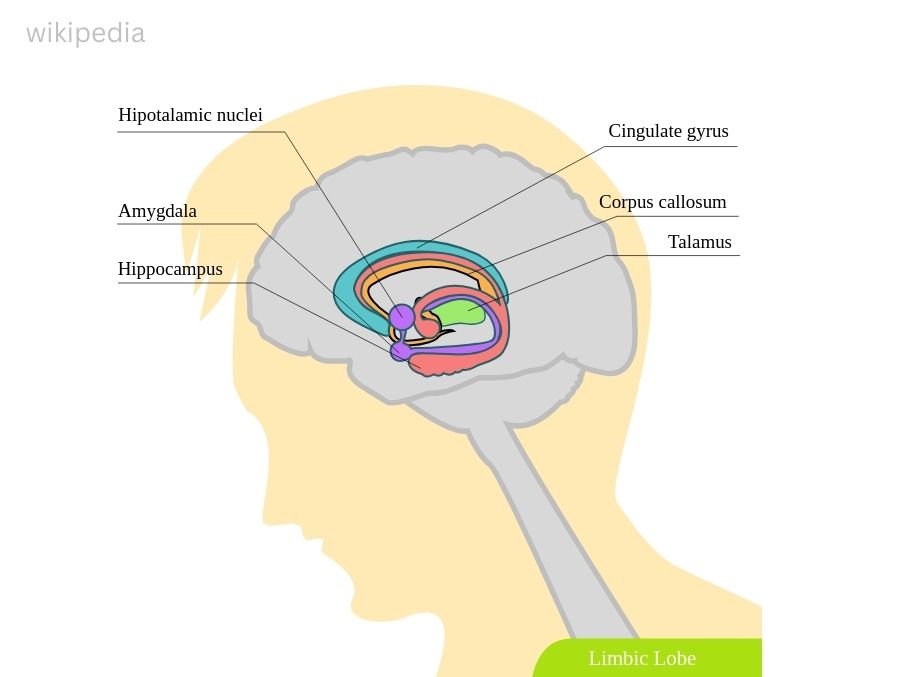Do you often wonder why we click with some people at once but not with others? Certain strangers feel close when we talk to but certain close ones feel like strangers at times. There might be both physical and emotional reasons behind this. Dr. Dan Siegel, a leading researcher in the field of interpersonal neurobiology and attachment, describes this as “feeling felt” by the other person in the room.
The feeling felt by another human goes beyond perception and is experienced even on a neurobiological level. When you make this connection with another person, some changes occur in the cells of your brain. The phenomenon is explained by limbic resonance, which states why such connections are so impactful.
Neurobiology behind Limbic Resonance
In the field of interpersonal neurobiology (IPNB), the sense of feeling felt as described above is known as Limbic Resonance. Researchers have linked this experience to the physical anatomy of our nervous system, specifically to a brain’s region known as the Limbic System.


Have you ever heard about the limbic system? The limbic system of our body comprises of thalamus, hypothalamus, hippocampus and amygdala. Each of these has its unique role in our body. For instance, the amygdala plays a major role in the activation of the fight-or-flight response, the thalamus helps us to track sensory input, the hypothalamus manages bodily sensations like thirst and hunger, the hippocampus is involved in memory storage and responsible for the control of emotional responses to the stimuli.
The limbic system is often called the emotional centre of our brain. Together, they work to form an emotional connection with another person. It allows us to react emotionally to situations. It processes what’s happening and helps us to identify the emotion that best fits the situation and react accordingly. It aids in processing, remembering, and regulating our emotions.
When we see a person and click with them at once, it is what is known as Limbic resonance. It is when both person’s limbic system aligns to form an emotional connection. There is no need for words to express how they feel about each other, their brain does the work. There’s this instant connection. While one’s relationship—might be romantic, platonic, or familial, when you feel that “instant click” without the need for verbal expression means that you’re experiencing limbic resonance. It is a vibrant thread that connects you with others.


The mirror neurons are special cells in our brain. You can get our perspective about other people’s emotions, thanks to these neurons. These neurons fire when an individual performs (or attempts to perform) a behaviour, and also when the individual observes someone else performing the same behavior. What this means is that our brain reacts to something we do not have to act at all, just watch someone else doing it. So let us say that if something is sad and you frown, certain neurons in your brain are fired. Even when you are not aware of why these others are melancholy, precisely the same neurons will baited if we look at other people’s frowns.
Mirror neurons mean that we can understand each other without words – especially for every deep connection in which you feel someone else’s feelings more acutely! The more we make use of these neurons, the more powerful they become. The more one connects with others, the more they make sense and are made senseless. One example is that of limbic resonance, which Dr. Curt Thompson a well-known psychiatrist who focuses on how the brain works relationally uses to address our desire to be fully known by other people. He found we can measure how connected we feel to one another via our shared limbic system, the part of our brain.
Dr Thomas Lewis, a psychiatrist and the author of A General Theory of Love writes about limbic resonance during good social exchange backgrounds, as is the case when you have an in-depth talk with another person, giggle together or physically touch each other. In these moments, the limbic systems of both people can synchronize with one another, allowing for shared emotional experiences. It does result in empathy, trust, and closeness between humans. Considered one of the main components of building strong relationships and social attachments.
Studies suggest limbic resonance is healthy for both physical and mental health. For example, it reduces tension and helps individuals feel more positive overall. Limbic resonance could be one of the reasons why they feel connected and that they are supported thus protecting them from stress and adverse health effects. Though limbic resonance may occur in numerous social situations, it is primarily identified with these close bonds present, such as those between romantic partners or parents and their children.
The Essence of Limbic Resonance
Emotion contagion — the ability to read another person and catch their emotions — the genuine understanding from one to another, is caused by limbic resonance. In fact, during limbic resonance, it can be thought of as two limbic systems singing together reconnecting and amplifying empathic feelings and bonding and lifting our happiness and well-being. It is the unseen thread interlacing the fabric of intimate relationships that ties us together in a way we don’t necessarily always understand. So, the limbic system is your body’s master regulatory system. Data collection happens in the outer environment and also the inner. That information or inputs are then collated and prioritized so the process of homeostasis happens on structural, physiological, and emotional levels.


The body’s sense organs constantly receive input from the outer and inner environment. There are five well-known traditional senses: sound, sight, taste, smell, and touch. But alas, there are more non-traditional senses that we are unaware of. For instance, let’s consider the kinesthetic sense. Kinesthetic sense means the sense of balance and relation to gravity, and also proprioception.
Kinokanesthesia is just one of the many interrelated systems through which we perceive and act upon the world around us utilizing our bodies in motion. Kinesthetic awareness encompasses all of the body’s physical feelings and movements experienced when in action, also including the traditional five senses.
What about electromagnetic fields, barometric pressure, light spectrum, sound wavelengths, or even cosmic forces? These are measurable influences even if we are unable to consciously appreciate them in experience. Our subconscious mind undoubtedly can respond to these inputs.
Many cut across non-verbal limits. I experience headaches when for example, I’m in the vicinity of big hanging cables, and I can feel coming weather changes with my joints several days ahead of the actual changes occurring. If I put on special glasses, my integrative brain functions improve. These are only a few illustrations of tangible sensory inputs. There are many more non-tangible sensory inputs.
For example, let’s consider an iceberg, as we know only about 25% is above water and 75% is underwater. The 25% which we can quantifiably create context, is the tangible realm. The really interesting part comes when talking about the other 75%. This is the mystery. This is the realm to which some individuals have access, often regarded as the paranormal or the psychic senses; however, it manifests as intuition for most people. Unknowingly, these inputs are affecting us 24/7.
In the non-tangible resides the force of resonance of the limbic system. Nurture is the word that seems appropriate especially when one considers the intangible. We have vibration within us that allows us to resonate and connect with the earth, plant, and mineral realms, other individuals, and even other living beings. Isn’t it intriguing to know what resonance is? It is a vibration, an energetic frequency. It can be too much to expect, but the harmonics do connect and create a triangulation with a reciprocating force. We have heard these phrases “We clicked at once” or “There was quite a chemistry between us from the moment we met” quite often. In other words, this is limbic resonance.
In the therapeutic context, we can call it a matching of vibration. The practitioner intends to be confident, clear, and connected while remaining present, receptive, and neutral. It is a wonderful example of mindfulness. When one experiences limbic resonance with clients, many possibilities can present themselves. We can get into a more inquisitive and creative side of our consciousness. Limbic Resonance serves as a complementary and enriches the technical capacity.
The Limbic System’s Influence on Bonding
At the heart of this emotional interplay lies the limbic system, a crucial component of our nervous system, that acts as our brain’s emotional center. This complex network governs emotions and memory. The limbic system including the amygdala, hippocampus, and thalamus shapes our most intense emotions and memories, laying the foundation for emotional connections that often define our relationships with others. Our initial bonding experiences we’ve felt in our childhoods leave a lasting impact on us. It can also affect our ability to form and maintain healthy relationships in adulthood. Brain chemistry also plays a major role in the process.
Factors Affecting Limbic Resonance
Of course, limbic resonance can never be guaranteed. We couldn’t experience it with just anyone or everyone. Even in your closest bloodlines, you might never feel it. That’s what makes it special. Several factors can affect Limbic Resonance, few are as follows:
Emotional Congruence: When two people share similar feelings or moods at the same time. They say physical proximity can help build the bridge to emotional congruence by synchronizing emotions between two people. However, just being physically close can’t result in limbic resonance. If one person is not emotionally available, then it’s highly impossible. The quality of the relationship including trust, safety, security, and mutual respect must be established to foster limbic resonance.
Applications of Limbic Resonance
Familial Relationships and Limbic Resonance
For parent-child relationships, an emotional connection is needed for the child’s emotional growth and development can be fostered by limbic resonance. These benefits of limbic resonance if available will not end in childhood either. It’ll shape who they’ll become in the future. It helps them to develop the ability to manage and regulate feelings, develop social skills, and build strong healthy relationships later in life.
Limbic Resonance in Therapy
Limbic resonance therapy serves as a connection that helps one flow through the stream of care and empathy that may be hampered by toxic stress. In therapy sessions, an empathic response is kindled through a mutual discussion process between the therapist and patients, and thus feelings are not only shared but felt profoundly. The road to an improved marital relationship is built on the specificities of limbic resonance therapy where the therapists focus on the aspects of the couple’s interaction. Beginning with the de-escalation stage to reviving intimacy, research-based techniques are employed to build and rehearse the relationship. These exercises are helpful for partners to understand their feelings and, consequently, the results of their behaviour. This process is useful for identifying the causes of conflicts as well as the factors that may result in recurrent conflicts.


Synchronizing Breathing and Staring
In the flow of the therapy, pranayama becomes one of the key elements of the work. When partners sing together, they inhale and exhale at the same pace and frequency; this facilitates a consistent and relaxed emotional state. The use of eye contact helps to foster intimacy and togetherness within the dance couple as one moves willingly with the other. With such activities as mirroring, then it will be quite evident that such couples have developed an even and attuned connection that can hardly be expressed through spoken language.
Gratitude Practice as well as Routine Communication
Specifically, the presence of digital devices as primary tools of interaction can undermine an individual’s emotional well-being by replacing direct human interaction with the passive consumption of screen content. The outcome can be an emotional drain, as the natural reciprocity of limbic resonance is disrupted. However, what offsets this is the need to have regular communication as well as to have an attitude of gratitude which helps to retain interpersonal relationships and also influences the well-being of human beings.
Such behaviours indicate a shift from solitary confinement associated with digital experiences, and reactions to reintroduce positive feelings in partners and elicit positive social interactions that echo the authentic act of being seen and appreciated.
FAQs
1. What is Limbic Resonance?
We click with some people at once without any verbal expression. According to psychology, our limbic system connects before we even talk, when that connection happens, it’s called Limbic Resonance.
2. What does the limbic system composed of?
The limbic system is composed of the amygdala, thalamus, hypothalamus, and hippocampus.
3. Why is the Limbic system called the emotional centre of our body?
Because the limbic system forms an emotional connection with another person. It allows us to react emotionally to situations. It processes what’s happening and helps us to identify the emotion that best fits the situation and react accordingly. It aids in processing, remembering, and regulating our emotions.
4. Can physical proximity lead to limbic resonance?
Just being physically close can’t result in limbic resonance. If one person is not emotionally available, then it’s highly impossible. The quality of the relationship including trust, safety, security, and mutual respect must be established to foster limbic resonance.
References +
- Center, B. a. C. (2024, April 16). The role of limbic resonance in couples therapy. Bay Area CBT Center. https://bayareacbtcenter.com/the-role-of-limbic-resonance-in-couples-therapy/
- Cnc, A. R. (2024, July 10). The Reason Why You Don’t Vibe With Everyone You Meet. Verywell Mind. https://www.verywellmind.com/limbic-resonance-8639765#:~:text=Limbic%20resonance%20can%20be%20considered,feelings%20deeply%2C%E2%80%9D%20suggests%20Reed
- Pollard, T. (2022, March 31). About limbic resonance. Full Life Christian Counseling. https://fulllifecc.com/2022/03/31/about-limbic-resonance/
- Schwartz, J. (2017, May 10). Limbic resonance – welcome to Dynamic Neuromuscular AssessmentTM. https://dna-assessment.com/limbic-resonance/
- Vee. (2023, March 8). Limbic Resonance. Ever heard of it? – Vee – Medium. Medium. https://mentalhealthmusings.medium.com/limbic-resonance-ever-heard-of-it-7b830c2e5b10







Leave feedback about this